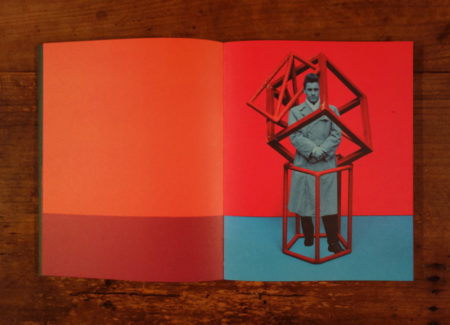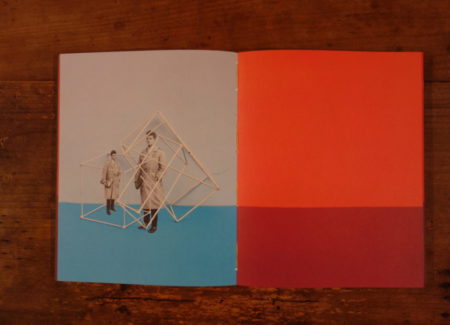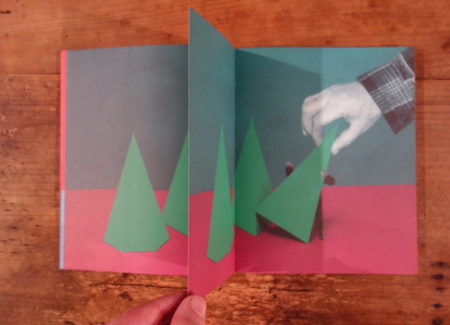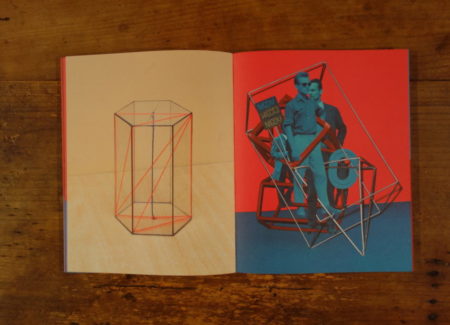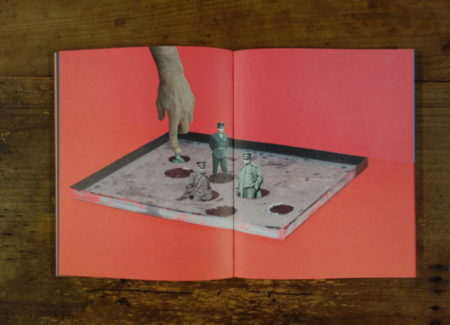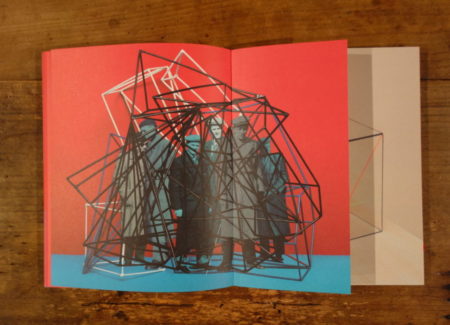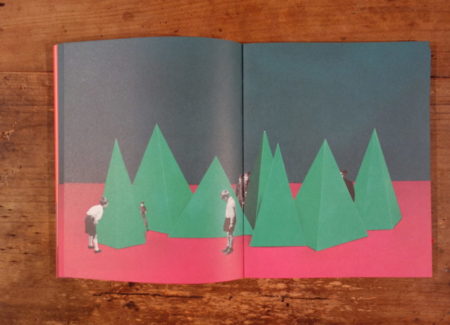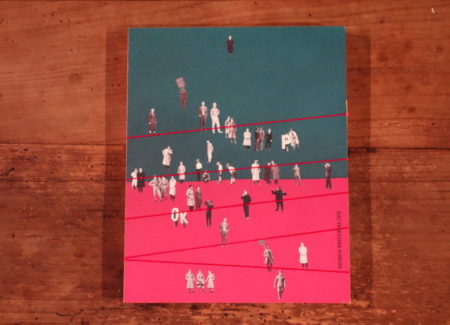JTF (just the facts): Published in 2017 by Muzeum Dzieci Wrzesińskich (book link here). Stitched hardcover in thick cardboard with thread enclosure, 72 pages, with 48 collages/photographs. Includes acknowledgement texts by Karol Szymkowiak and the artist, and a transcribed email exchange between Maciej Pisuk and the artist as an insert (all texts in Polish/English). In an edition of 600 copies. (Cover and spread shots below.)
Comments/Context: The Polish photographer Rafal Milach is quietly establishing himself as a consistently innovative maker of photobooks. His excellent 2014 book, The Winners (reviewed here), subversively documented the victors of state sponsored competitions and contests in contemporary Belarus – employing a clever hinged-page design, it revealed undercurrents of dark absurdity amid the tightly controlled photo ops. And his newest offering, entitled The First March of Gentlemen, is even more ambitious – it boasts one of the most striking and expressive photobook designs of 2017.
The First March of Gentlemen was made during a recent artist residency program in the town of Września in western Poland. For the better part of the past decade, the town has commissioned one photographer each year to make a body of work illustrating the town and its residents, with very few artistic constraints. Each residency culminates in a published photobook and an exhibition, the annual project bringing an outside perspective to everyday life in the region and forcing a reconsideration of the town’s evolving identity, both past and present. Milach began his time in Września by diving into the archives/collections of various local photographers active during the 1950s, and it was there that he found both his initial inspiration and the raw material for his eventual project.
Particularly among the vintage black and white photographs of Ryszard Szczepaniak, Milach discovered unexpected patterns of behavior and attitude among the city’s young men – they seemed to exude a certain kind of wise guy indifference to the real struggles taking place at the time. Well-dressed in suits, overcoats, and jaunty hats and standing with self-satisfied ease, they felt like a parody of the upstanding young men they were supposed to be. The smiles on their faces were alternately restrained, smug, and almost mocking, alluding to their overall sense of arrogant confidence. The images of soldiers and officers Milach unearthed also had the same easy going air of privilege and control. All of these men were seemingly friends, brothers, or like-minded elites, and they seemed overtly oblivious to or dismissive of the tumult of Communism and strict government control gripping the nation.
Perhaps the most famous moment in Września’s history came half a century earlier, and Milach wanted to incorporate that collective memory into his works as well. Back in 1901, the local children went on strike against the increased influence of German/Prussian culture in their schools, and in particular, against the compulsory study of the German language. Milach has channeled that rebellious connection by making a selection of still life images of worn mathematical and geometrical models found in a local school. Once used as teaching aids, these welded metal cubes, pyramids, polygons, and stick/ball constructions are both wholly abstract and obliquely refer back to the facts of local history.
Armed with these two sets of imagery, Milach then proceeded to construct a series of intricate photocollages that cunningly merge the two. Like the spare Bauhaus compositions of László Moholy-Nagy and Marianne Brandt, Milach’s collages isolate the bodies and geometric models from their original surroundings and place them into unlikely combinations and resonant situations. Many of the works pile the men into tight clusters, turning individuals into gatherings or even fabricated “demonstrations” and “protests”. These groups are then placed inside the elemental mathematical forms, the interlocked edges and vertices creating something akin to cages or jails (the wrapped string enclosure that surrounds the book itself also echoes this feeling). Set against brightly colored two-tone backdrops that create a modified sense of depth and space, the resulting compositions are both boldly abstract and charged with symbolic historical relevance.
Several works go on to turn a group of opaque volumes into a makeshift landscape, with tiny figures placed in among the steep pyramids and semicircular halves. Using half cut pages to interrupt the visual flow, Milach creates clever sequential games of page-turn hide and seek, with children looking for hiding soldiers behind green “trees” and men squeezed into the yawning mouths of open cylinders. The artist uses a similar time lapse, stop motion effect in a series of images that replicates the meandering gathering of a crowd, with individuals and small groups slowly arriving and milling around. And he even turns a handful of soldiers into an improvised Whack-A-Mole game, with figures popping up from holes on a piece of painted wood and being pressed down by fingers from the sky.
In The First March of Gentlemen, Milach has delivered an intimate photobook experience that is both playful and quietly sophisticated, and this duality gives it much of its freshness and vitality. Its approachable simplicity draws us in, where we then alternate between formal and historical readings of his incisively smart compositions. In both construction and context, this is a photobook that memorably stands out, fervently reminding us that thoughtfully imagined old school photocollage can still be exciting and relevant.
Collector’s POV: Rafal Milach does not appear to have gallery representation at this time. Interested collectors should likely follow up directly with the artist via his website (linked in the sidebar).



